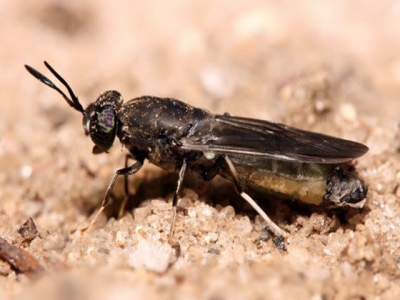Nuffield Scholar talks of benefits of insects for hens

Feeding insect protein to laying hens has the potential to take off around the globe but further technical knowledge of entomology is crucial for its viability.
Photo: Shutterstock
Nuffield scholar Dr Aidan Leek said there was growing evidence that the former small-scale and niche sector was turning into an industrial and mainstream operation.
Dr Leek, poultry nutritionist with Trouw Nutrition, said there had been more research papers in the field since a major conference at the University of Wageningen in 2014 than ever before. French firm Ynsect and Canadian company Entomo Farms were leading the way in industrial production.
Current rules for insect protein in hens inconsistent
The regulatory use of insect protein for hens was currently rather inconsistent, he added. Canada had allowed insect protein in broiler feed since 2016 and 1 firm was looking to build 20 factories across north America. But, in the United States the use of distillers grains and meat and bonemeal meant that there were questions over the economic viability of using insects.
Asia and Africa: Less hurdles for insect protein
In Asia and Africa there were fewer hurdles to overcome due to less regulatory controls and lower costs of production, such as labour and energy, as well as protein shortage. One South African company was planning to build 100 fly farms by 2024 and 200 by 2027, each producing 5,000 tonnes per annum of protein. The firm was looking to relocate to London.
Starting in the insect business: Factors to consider
Dr Leek stressed there were a number of economic factors to take into account before embarking on moving into the insect business. “These include proximity to low cost input material, low cost energy inputs, surface area, scalability and market access.
Species selection
“But above all it is important to have a technical knowledge of entomology,” he stressed, which would help determine the species selection.
If producers were using mixed organic material they might consider using the black soldier fly and if the organic material contained consumer waste the house fly could be appropriate. If the material contained manure or blood then blow fly would be ideal. Palm weevil larvae could be used in South East Asia with palm waste and similarly, silk worm could be used in Indian by-products. Costs of input materials were vital as margins were currently tight, he added.
Nutritional value of insect protein
Insect protein was high in calcium but was deficient in certain amino acids and he warned there could be problems if there were heavy metals, such as lead, in substrate material.
Protein concentrates could be improved by removing Chitin, a primary component of insect exoskeletons. Although separation was technically difficult and expensive, there were lucrative markets in the bioplastics, cosmetics and medicines sectors.
Market possibilities for insect meal
Dr Leek said the primary target was for fishmeal replacement, but he said insects could be used for specialist turkey starter, broiler and pullet diets and in the organic sector. It would be of less value potential for the poultry industry than the aqua and pet sectors, but of higher value than for the pig industry.
“One question you need to ask if can you build a brand and market it as something different,” he added.
Related news
 Progress on OIE Global Hen Housing Standards
Progress on OIE Global Hen Housing Standards Progress on the OIE’s Global Hen Housing outcome-based standards is taking place but may not come into force until 2019/2020.
 The role of enzymes and lysolecithins in eubiotic nutrition
The role of enzymes and lysolecithins in eubiotic nutrition The ban on animal proteins and consequently the sole use of vegetable proteins since the year 2000, and the complete ban on antibiotic growth promoters since
 Broiler breeders strive for balance in their lines
Broiler breeders strive for balance in their lines Continued evolution of the industry and consumer preference has and will undoubtedly continue to influence the shape of broiler breeder selection programs.